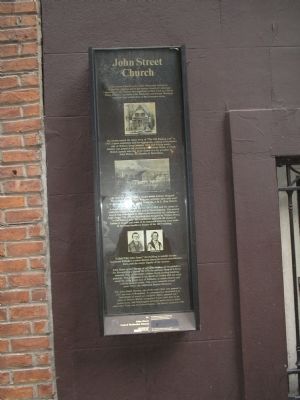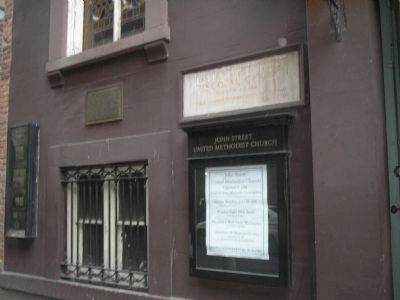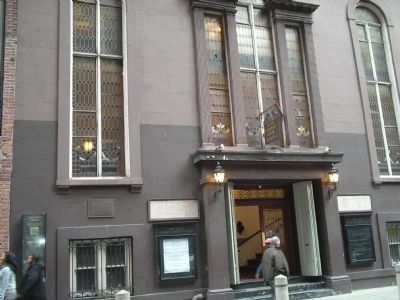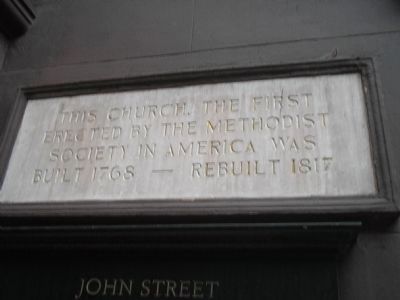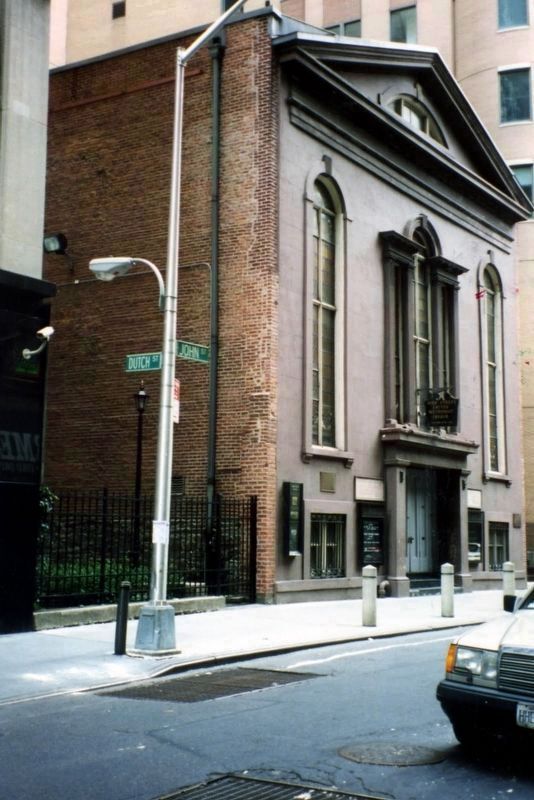Financial District in Manhattan in New York County, New York — The American Northeast (Mid-Atlantic)
John Street Church
Heritage Trail
The society rented the upper story of “The Old Rigging Loft” in 1767, a space sometimes used for rigging sails, located on the eastern side of William Street between John and Fulton streets. Embry was joined in his preaching by Thomas Webb, a retired British captain who was given license as a lay preacher by John Wesley, the founder of Methodism.
In 1768 the society built a chapel which Embury designed. The first sexton was Peter Williams, a former slave who won emancipation and helped found the A.M.E. Zion Church.
A larger church was built on this site in 1818 and the stones of Embury’s original chapel were laid in the foundation. The second church was demolished in 1840 to accommodate the widening of John Street. The present structure was designed by William Hurry in the Federal style. Its foundations still hold the stones of Embury’s chapel and some of its structural elements were made of the stout, handhewn beams of the 1817 building.
Called “Old John Street,” the building is notable for the handsome Palladian window directly above the broad main entrance door, and the simple dignity of the interior.
John Street is also the site of an early incident of bloodshed in the Revolutionary period. In 1770 the patriotic Sons of Liberty attacked three of the king’s soldiers found posting insulting placards. This culminated in the Battle of Golden Hill (an early name for John Street east of William), in which citizens and soldiers clashed briefly. This event occurred several years before the celebrated Boston Massacre.
The John Street Theater, one of the city’s first, was opened in 1767 just east of Broadway. A contemporary described it as “principally of wood, an unsightly object, painted red.” General Howe’s British occupation forces took part in its productions, and Washington attended performances there when New York was the federal capital. The theater closed in 1798.
Topics and series. This historical marker is listed in these topic lists: Churches & Religion • Colonial Era • War, US Revolutionary. In addition, it is included in the African Methodist Episcopal Zion (AME Zion) Church series list. A significant historical year for this entry is 1766.
Location. 40° 42.548′ N, 74° 0.482′ W. Marker is in Manhattan, New York, in New York County. It is in the Financial District. Marker is on John Street
, on the right when traveling east. The markers are on the front of the John Street Church. Touch for map. Marker is at or near this postal address: 44 John Street, New York NY 10038, United States of America. Touch for directions.
Other nearby markers. At least 8 other markers are within walking distance of this marker. John Street Methodist Church (here, next to this marker); a different marker also named John Street Methodist Church (here, next to this marker); a different marker also named John Street Church (here, next to this marker); Former Residence of Thomas Jefferson (within shouting distance of this marker); 33 Liberty Street (within shouting distance of this marker); John Street (about 300 feet away, measured in a direct line); Federal Reserve Bank of New York (about 400 feet away); The Liberty Tower (about 400 feet away). Touch for a list and map of all markers in Manhattan.
More about this marker. Pictures of “The Old Rigging Loft” circa 1767 and Wesley Chapel, 1768, appear near the top of the marker. Below this are pictures of Philip Embury and Peter Williams.
Also see . . .
1. John Street Church. Church website (Submitted on June 6, 2009, by Bill Coughlin of Woodland Park, New Jersey.)
2. Battle of Golden Hill. Wikipedia entry (Submitted on June 6, 2009, by Bill Coughlin of Woodland Park, New Jersey.)
3. The John Street Methodist Church - 44 John Street
. "Daytonian in Manhattan" entry. (Submitted on April 11, 2020, by Larry Gertner of New York, New York.)
Credits. This page was last revised on January 31, 2023. It was originally submitted on June 6, 2009, by Bill Coughlin of Woodland Park, New Jersey. This page has been viewed 1,434 times since then and 21 times this year. Photos: 1, 2, 3, 4. submitted on June 6, 2009, by Bill Coughlin of Woodland Park, New Jersey. 5. submitted on April 11, 2020, by Larry Gertner of New York, New York.
